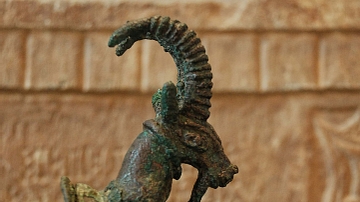Illustration
This winged ibex was a handle for a metal amphora-shaped vessel, made in the 4th century BCE in Achaemenid Persia. This high level of detail was achieved through the use of lost-wax technique.
It has been suggested that this piece of art resembles both the god Bes and the Greek god Silenus, which may indicate that a Greek artisan made this piece of art.
Louvre Museum, Paris. Sully wing, ground floor, Room 12a.
H: 27cm
W: 15 cm
D: 10cm
About the Author
Cite This Work
APA Style
Crabben, J. v. d. (2015, May 18). Winged Ibex Vessel Handle. World History Encyclopedia. Retrieved from https://www.worldhistory.org/image/3871/winged-ibex-vessel-handle/
Chicago Style
Crabben, Jan van der. "Winged Ibex Vessel Handle." World History Encyclopedia. Last modified May 18, 2015. https://www.worldhistory.org/image/3871/winged-ibex-vessel-handle/.
MLA Style
Crabben, Jan van der. "Winged Ibex Vessel Handle." World History Encyclopedia. World History Encyclopedia, 18 May 2015, https://www.worldhistory.org/image/3871/winged-ibex-vessel-handle/. Web. 07 May 2025.








